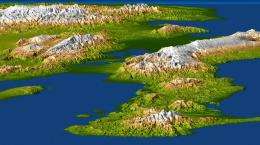Fault Responsible for Haiti Quake Slices Island's Topography

(PhysOrg.com) -- The fault responsible for the Jan. 12 magnitude 7.0 earthquake that devastated Haiti is visible in images created using NASA radar topography data acquired in 2000.
This perspective view of the pre-earthquake topography of the area, created using data from the Shuttle Radar Topography Mission that flew aboard Space Shuttle Endeavour in February 2000, clearly shows the Enriquillo fault that is apparently responsible for the earthquake. The fault is visible as a prominent linear landform that forms a sharp diagonal line at the center of the image. The city of Port-au-Prince is immediately to the left (north) at the mountain front and shoreline.
Elevations in the image are color coded from dark green at low elevations to white at high elevations, and the topography is shaded with illumination from the left. The topography in this image is exaggerated by a factor of two.
Image details:
A magnitude 7.0 earthquake occurred on January 12, 2010, at Port-au-Prince, Haiti, with major impact to the region and its citizens. This perspective view of the pre-quake topography of the area clearly shows the fault that is apparently responsible for the earthquake as a prominent linear landform immediately adjacent to the city. Elevation is color coded from dark green at low elevations to white at high elevations, and the topography is shaded with illumination from the left. The topography in this image is exaggerated by a factor of two.
The sharp diagonal line exactly at the image center is the Enriquillo fault. Port-au-Prince is immediately to the left (north) at the mountain front and shoreline. The Enriquillo fault generally moves left-laterally (horizontally, with features across the fault shifting to the left when the fault breaks in an earthquake), but vertical movements occur along the fault where irregularities in the fault line cause local compression or extension of the earth. Meanwhile, movements of the topography at the Earth's surface can falsely appear to be vertical where mountain slopes are cut and misaligned by horizontal shifts of the fault. Additionally, differing erosion rates on the two sides of the fault, due to the juxtapositioning of differing rock types by the fault, can give the appearance of vertical offsets of the current topographic surface. All of these real and apparent horizontal and vertical offsets of the topographic surface may (and likely do) occur here, making the fault easily observed in the topographic data.
The elevation data used in this image were produced by the Shuttle Radar Topography Mission (SRTM), flown aboard Space Shuttle Endeavour in February 2000. SRTM acquired elevation measurements for nearly all of Earth's landmass between 60 degrees North and 56 degrees South latitudes. For many areas of the world, SRTM data provide the first detailed three dimensional observation of landforms at regional scales. The mission was a cooperative project between the National Aeronautics and Space Administration (NASA), the National Geospatial-Intelligence Agency (NGA) of the U.S. Department of Defense (DOD), and the German and Italian space agencies. It was managed by NASA's Jet Propulsion Laboratory, Pasadena, Calif., for NASA's Science Mission Directorate, Washington, D.C.
View Width: One degree latitude (111 kilometers, or 69 miles)
View Distance: Five degrees longitude (525 kilometers, or 325 miles)
Location: 18 to 19 degrees North latitude, 70 to 75 degrees West longitude
Orientation: View east, 5 degrees below horizontal
SRTM Data Acquired: February 2000
Provided by JPL/NASA

















